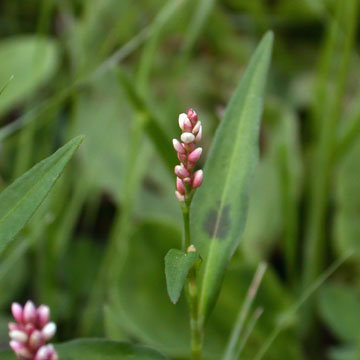

Persicaria pensylvanica - (image 1 of 3)
Taxonomy
Family: Polygonaceae
Synonymous with Polygonum pensylvanicum L.
Habitat
Fields, lawns, gardens, waste ground, often in rich, moist soil.
Associates
Distribution
Nova Scotia and Quebec to MN and SD, south to FL and TX.
Morphology
Annual; stems erect, branching, to 2 m, or rarely prostrate; leaves lanceolate, acuminate; ocreae becoming lacerate, but not fringed-ciliate at the summit; racemes numerous, erect, typically cylindric, blunt, 1.5-3 cm; ocreolae ovate, entire or minutely ciliate; perianth pink or white, scarcely exceeding the achenes, 5-lobed to below the middle, the segments with several obscure, branched and anastomosing veins; achenes lenticular, concave on both sides, 2.6-3.4 mm, 85-100% as wide.
Notes
Flowers July to October
Wetland indicator: FACW
A common weed of gardens. Similar to P. lapathifolium but the inflorescences shorter and more erect, and the flowers with 5 tepals rather than the 4(5) typical of P. lapathifolium.
References
Gleason, Henry A. and A. Cronquist. 1991. Manual of Vascular Plants of Northeastern United States and Adjacent Canada. Second Ed.
The New York Botanical Garden. Bronx, NY
USDA, NRCS. 2002. The PLANTS Database, Version 3.5 (http://plants.usda.gov).
National Plant Data Center, Baton Rouge, LA 70874-4490 USA.
|
Michael Hough © 2018 |